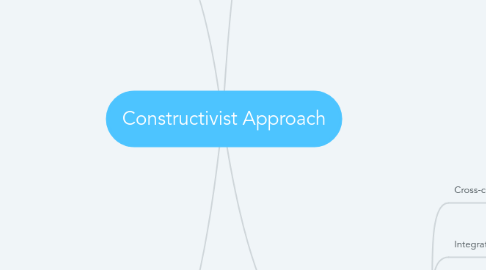Constructivist Approach
создатель Madison Mackenzie


1. Teaching Approaches
1.1. Create opportunities to build on past learning.
1.2. Ability to integrate exceptional students in a way that they can access the same material being covered or discussed.
1.3. Leave ample time for collaboration and discussion.
1.4. Allow students to work in varied groupings, placing weaker students with stronger ones occasionally to ensure everyone works together.
1.5. Diversify learning scenarios for students. For example: -Independently -Cooperatively -Individually -With teacher direction -Through hands-on experience -Through examples followed by practice
1.6. Assign tasks that encourage students to look for patterns and relationships and engage logical inquiry.
1.7. Fostering communication skills, provide opportunities to ask questions, question students, make conjectures, share and clarify ideas, suggest and compare strategies and explain their reasoning.
1.8. It is important to select material and strategies that elicit mathematical reasoning from students.
1.9. Community partnerships that foster integration of parents as partners and supporters of student achievement in math.
2. Assessment
2.1. Know that student learning does not always have to be represented in written form.
2.2. Listening to their discussions and reasoning, offering effective questioning and direction can identify their learning.
2.3. Prompt proof of learning by asking simply, "How do you know?"
3. Learning Environment
3.1. A variety of physical objects and manipulatives to work with and explore.
3.2. Space to work on the floor or to move around the classroom.
3.3. Fostering communication skills
3.4. Promote positive learning environment by encouraging students to feel safe to explore their ideas and come to know that there may be many avenues to get to the right answer.
3.5. Use of technology if/when needed.
3.6. Display student thinking to reflect current mathematics topics.
4. Curriculum
4.1. Cross-curricular
4.1.1. Provide opportunities for students to make connections and use learned mathematics between two or more other subject areas.
4.2. Integrated learning
4.2.1. Provide students with opportunities to learn and use related content/skills in two or more subjects.
4.3. Problem based questions
4.3.1. With multiple approaches.
4.4. Engaging students as co-learners in their development of their mathematical thinking.
4.5. Take on mathematical tasks that are meaningful to students.
4.6. Foster questioning
4.6.1. Teacher - student, student - student, student - teacher.
4.7. Develop learning goals and success criteria based on student thinking and reasoning.
4.7.1. Use this information to plan forward.
